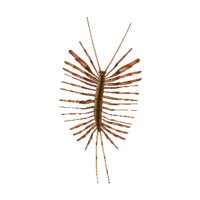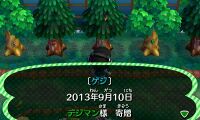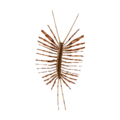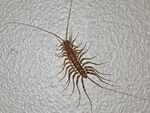House centipede
| ||||||||
 | ||||||||
| Real-world info | ||||||||
|---|---|---|---|---|---|---|---|---|
| Name: Scutigera coleoptrata Family: Scutigeridae | ||||||||
| Main appearances | ||||||||
|
| ||||||||
| Other appearances | ||||||||
Names in other languages
ゲジ
N/A scutigère ciempiés doméstico centogambe N/A
그리마 N/A scutigère ciempiés doméstico Spinnenläufer N/A | ||||||||
The house centipede[nb 1] is a bug in Animal Crossing: New Leaf found between late summer and early fall by striking rocks with a shovel. Like the centipede, it will make a rattling noise while moving.
Catch details[edit]
In New Leaf[edit]
| Time of year | Aug – Oct |
|---|---|
| Time of day | 7 PM – 8 AM |
| Peak times | N/A |
| Location | From hitting rocks |
| Size | Unknown |
| Rarity | Common |
| Selling price | |
| Furniture size |
Donating to the museum[edit]
In New Leaf[edit]
Gallery[edit]
Real-world information[edit]
Originating in the Mediterranean region, the house centipede has spread to other parts of the world, where it can live in human homes. It is an insectivore; it kills and eats other arthropods, such as insects and arachnids. Outdoors, house centipedes prefer to live in cool, damp places. Most live outside, primarily under large rocks, piles of wood, and especially in compost piles. Within the home, these centipedes are found in almost any part of the house. Most commonly they are encountered in basements, bathrooms, and lavatories, which tend to be humid, but they can also be found in drier places like offices, bedrooms and dining rooms. The greatest likelihood of encountering them is in spring, when they come out because the weather gets warmer, and in fall, when the cooling weather forces them to find shelter in human habitats.
Names in other languages[edit]
| ゲジ geji |
||
| Spinnenläufer | Spider runner | |
| Ciempiés doméstico | Domestic centipede | |
| Scutigère véloce | Combination of Scutigera, the house centipede's genus in the family Scutigeridae, and the word swift | |
Notes[edit]
| Bugs | |||||||||||||||||||
|---|---|---|---|---|---|---|---|---|---|---|---|---|---|---|---|---|---|---|---|
| |||||||||||||||||||



